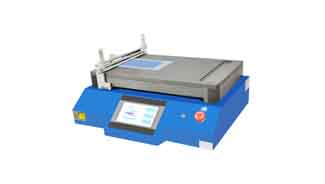The machine used for spin coating is called a spin coater.
A spin coater is a device used to apply a film to a substrate. The system will rotate the substrate at different speeds while the coating material is distributed to its surface. As the fluid spins off the edge of the substrate, it continues to rotate until the film reaches the desired thickness.
A spin coater was used in the spin coating process.
Spin coating is a commonly used technique for coating films on substrates. When a solution of a substance and a solvent is spun at high speed, the centripetal force and surface tension of the liquid together create a uniform coverage. When the remaining solvent evaporates, the spin coating will form a thin film with a thickness ranging from a few nanometers to a few microns.
Spin coating is widely used in various industrial and technical sectors. Compared with other methods, its main advantage is that it can produce very uniform films quickly and easily.
In organic electronics and nanotechnology, the use of spin coating is widespread and is based on many technologies used in other semiconductor industries. However, the relative thin film and high uniformity required for effective device fabrication, as well as the self-assembly and organization required during the casting process, do require some differences in methods.
The spin coating usually refers to uniformly coating a thin film (a few nanometers to a few micrometers) on the surface of a substrate, and coating (casting) a solution of the required material in a solvent ("ink") during rotation. Simply put, it is to deposit a liquid solution on a rotating substrate to produce a thin film of solid material, such as a polymer.
The high-speed rotation of the substrate means that the centripetal force and the surface tension of the solution combine to pull the liquid coating into a even coverage. During this period, the solvent evaporates, leaving the required material to be evenly covered on the substrate.
This process can be roughly divided into 4 main steps:
Deposition
Spin up.
Spin-off
Evaporation
In the initial step, a solution is usually used to cast the solution onto the substrate. Whether the substrate is already spinning (dynamic spin coating) or is spun after deposition (static spin coating), centrifugal motion causes the solution to spread on the substrate.
The substrate then reaches the desired rotation speed-either immediately or following a lower speed diffusion step. At this stage, most of the solution is discharged from the substrate. Initially, the rotational speed of the fluid may be different from the base, but eventually, when the resistance balances the rotational acceleration, the rotational speed will match the base, causing the fluid to become horizontal.
Due to the viscous force, the fluid now begins to thin. When the liquid is thrown out, the film usually changes color due to interference effects. When the color stops changing, this will indicate that the film has basically dried. Sometimes an edge effect occurs because the fluid must form droplets at the edge to be ejected.
Finally, the flow of fluid stops, and the dilution is mainly due to the evaporation of the solvent. The rate of solvent evaporation depends on the volatility of the solvent, vapor pressure, and environmental conditions. The non-uniformity in the evaporation rate, such as at the edge of the substrate, will lead to the corresponding non-uniformity in the film.
We are a spin coater manufacturer. Please feel free to contact us if you are interested in our products.

评论
发表评论